28-Days-to-Lean Meal Plan
With the right plan and the right discipline, you can get seriously shredded in just 28 days.
Read article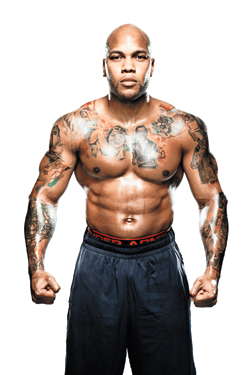
Fourteen-year-old Tramar Dillard is pinned under a 150-pound barbell in his friend’s backyard. No way he’s getting this bar off his chest. Not without some help, anyway. Young Dillard is athletic, having honed his skills for years on basketball courts near his home in Miami’s Carol City 187th street projects, but this is a different story. Not only does the weight feel heavy, but he can hardly even balance the bar in his hands. Truth be told, the boy is a little scared. “Wow, this is serious,” he says to himself. “I’m not that strong.”
Yet while he may have lacked innate physical strength, Dillard more than made up for it in persistence. “I just kept going to that backyard and lifting, me and a couple of my friends,” says Flo Rida, now 32. “I was just getting into high school—you don’t want to be the puny guy—so I dedicated myself every day, sometimes twice a day, to working out.”
It’s that same dedication, that same persistence that would drive Dillard not just in the gym, but through his entire existence. Adopting the stage name Flo Rida a few years after his sobering initiation into the world of weights, he would become one of the biggest rappers ever to come out of the sunshine state, breaking itunes sales records, earning Grammy nominations, and taking trips around the world promoting his music. While Dillard may have been owned by a 150-pound barbell in his first workout, Flo Rida would be the one to do the owning—in the gym, on the stage, in the charts—from that point on.
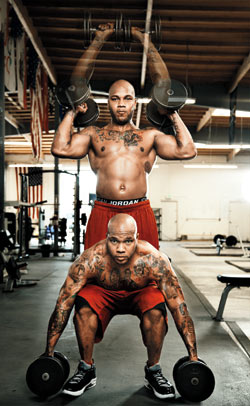
Dillard is up at one o’clock in the morning doing 500 dips on his balcony where the railing forms a V shape. Sometimes he does 300 pushups when everyone else is asleep so that he can “be more advanced and look more swole the next day.” The daily workouts after school at Miami Carol City High—all the squats, pullups, and weighted dips with a 45?pound plate dangling from his waist— aren’t enough. Dillard has to be stronger than his friends, has to be able to bang out more pushups than them at a moment’s notice. He has to make that first bench?press workout a forgotten memory.
“It was a competition [among friends]—who could lift the most weight,” Flo Rida says. “Aside from lifting weights, if we were just walking around the neighborhood, we’d drop down and do some pushups. Get a deck of cards and whatever card you flip over, that’s how many pushups you do.”
Early influences, as trivial as they may seem at the time, can be a young man’s salvation or his ruination. “I remember my next? door neighbor—he used to go out on the balcony and do dips,” Flo Rida says. “And I’d watch him and be like, ‘What is he doing?’ Actually, both neighbors—the one on my right and the one on my left— would do them, and eventually it was just something I tried because I saw them do it, and I’m glad it was something positive. Those two guys influenced me, as well as watching Arnold Schwarzenegger [in movies].”
If you think every kid growing up in the projects is up to no good, note that Dillard was an exception. Between endless hours spent making music with his rap group, The GroundHoggz, lifting weights obsessively, and playing basketball for the Miami Carol City team, he was mostly able to dodge the improprieties that plagued so many of his peers on 187th Street, a rough area Flo describes as “the bottom of the slums” in his landmark 2009 release R.O.O.T.S. (an acronym for Route of Over? coming the Struggle). His music and his training, especially the former, served as cocoons that shielded him from the gunshots piercing his apartment complex, the SWAT officers camping out on the roof overhead, and drug dealers looking for someone to help them stash their cocaine.
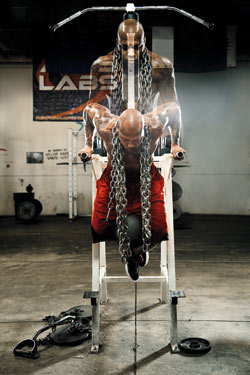
While honing his craft as a teenage rapper, Dillard also transformed his physique— parallel developments that, given the amount of muscle he flashes in videos and onstage, seem too intertwined to be coincidental. Almost immediately, he could see his body getting more “cut up,” and by the summer before his sophomore year, his forearms had grown significantly and his pecs were bulging. “I had more of the ladies, you know, hit? tin’ on me,” he says.
By his senior year, Dillard was one of the strongest kids at his high school. The third strongest, by his estimation, even when you count the offensive and defensive linemen on the football team. He was bench?pressing 370 pounds, but that wasn’t his most impressive lift. He once deadlifted 500 pounds while wearing sandals. The training helped his basketball game. At only around 6’1″ (Flo Rida is now 6’21⁄2″) he was regularly guarding centers. “I wasn’t even tall enough to be a center,” he says, “but they would line me up against the centers, because I was so strong they couldn’t really stay in the paint.”
Flo Rida jogs alongside a red convertible Mini Cooper in normal day traffic in some European city. He’s shirtless and his many upper?body tattoos, not to mention his chiseled, 233?pound physique, are on display for all to see. After shooting the “Good Feeling” video, a throng of admirers now follow behind him, Forrest Gump–style. This is what has become of Dillard since his days in Carol City, thanks to a work ethic both in the studio and in the gym that hasn’t ceased.
The first words out of Flo Rida’s mouth in the song are “Yes I can,” and the last ones are “Gotta love the life that we livin’.” These lyrics, along with the images depicted in the video, sum up Flo’s lifestyle perfectly. Sold?out concerts. VIP seating at high?end nightclubs. Hanging with Snoop Dogg backstage. Beautiful women. Expensive cars. Traveling from city to city. Luxury hotel suites. Lounging in swimming pools during his downtime to relax and enjoy the good life. Training in the gym like a prize fighter, and showing off all the hard work onstage with his shirt off and champagne pouring down his head and torso.
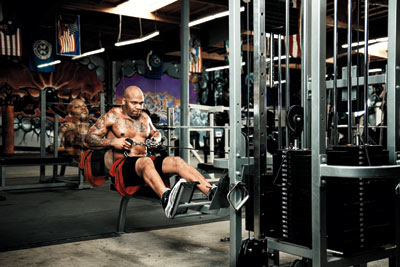
Flo Rida is four albums into a career that took off in 2007 with the single “Low,” a commercial hit that reached No. 1 on the Bill? board Hot 100 chart and earned two Grammy nominations. With other songs like “Right Round,” “In the Ayer,” and “Wild Ones” having also achieved mainstream success, Flo’s music can best be described as a hybrid of hip?hop and pop, the kind heard blaring in night clubs, on the radio, and on millions of iPods worldwide.
His popularity is soaring at the moment, with more than 600,000 followers on Twitter and a recent appearance at WWE’s WrestleMania XXVIII leading up to The Rock’s beating John Cena in an instant?classic main event. Not surprisingly, Flo Rida travels regularly—like the Australia and New Zealand trips that preceded his M&F photo shoot in L.A. in April—and always in the company of his trainer, Tony Bradham, who takes him through high?intensity circuit routines (see page 112) at whatever gym they can find in whatever city they’re visiting.
Without the training, neither the physical demands of performing onstage nor Flo’s physique?conscious image would be sustainable. “Working out definitely helps me onstage,” he says. “When I haven’t worked out I don’t have as much energy. A lot of times I’m onstage for more than an hour, hour and a half, and just doing the cardio and the boxing that I do, it helps me out. And a lot of girls, you know, they love guys with muscles. And I use that to my advantage when I’m onstage, taking off my shirt and things like that.”

Flo Rida walks through an airport somewhere—New York or Paris or anywhere else he’s in demand for live shows or in?store album promotions. Maybe yesterday or today or a week ago. Someone catches his eye at the magazine rack, so he stops. It’s him—looking out from the cover of this magazine.
He used to read the muscle magazines growing up. Other than Arnold, he recalls being inspired by Lou Ferrigno, who also started out in the gym and ended up on TV screens everywhere, a million miles from the Miami projects Tramar Dillard hoped to one day represent in his music. Not too long ago, yet another famous veteran M&F cover model caught his eye, an experience that hit closer to home given their shared profession.
“I was at the airport, going to Miami,” Flo Rida says. “I picked up the Muscle & Fitness with 50 Cent on it [February 2010 issue], and I said, ‘Man, I need to get in this magazine, like for real.’ And then all of a sudden I got the call.”
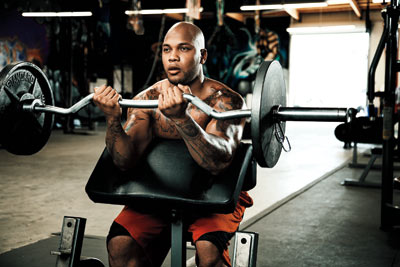
Flo With It
Flo Rida doesn’t just Flow with the rhymes, he Flows with his workouts, too. Under the watchful eye of trainer Tony Bradham (a former pro boxer and sparring partner for Lennox Lewis), Flo’s routine is more like a freestyle rap than a scripted song. Bradham’s program strings together traditional exercises plus ones he’s developed himself. the workout is a kind of giant whole?body circuit that com? bines compound and isolation lifts with novel plyometric moves, coupled with boxing training. “I make him work,” Bradham says. “If he’s cursing at me during the workout, then I know I’m doing my job.” “It’s brutal,” Flo adds. “We don’t let up—not for a minute. We’ll go like that for an hour and ten minutes straight.”
Even more impressive? Bradham and Flo generate this nonstop intensity seven days a week, sometimes twice a day. And this isn’t just because Bradham is some kind of sadistic taskmaster hellbent on driving his client into the ground (which he is, in a good way). “I could be in the gym all day if I had the time,” Flo says. “It’s just something I love.” so much so that at the end of this photo shoot, which came after a two?hour morning workout, he exclaimed, “I could do the whole thing all over again if you want me to.”
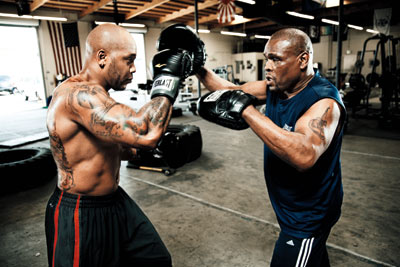
SAMPLE FLO RIDA WORKOUT*
A typical Flo Rida workout isn’t very typical at all. While it consistently runs for an hour to 1:15, and wraps with 20 minutes of ab training, each session is unique in terms of reps (usually in the 8–10 range) and exercise selection. All moves are performed back to back, in a circuit, with no rest at all. When the guys are feeling particularly strong they’ll run through it twice in a row.
Preacher Curl// Dumbbell Curl into Overhead Press // On Flo // Power Flo // Sho Off // Flo Sho // Alternating-Arm Medicine Ball Pushup // Wide Grip Pulldown // Tug of War // Incline Bench Press // Deadlift// Hack Squat // 45 Degree Leg Press // Leg Extension // Leg Curl // Medicine Ball Incline Sit-up // Captains Chair Leg Raise
Glossary Of Flo Rida’s Exercises Here are a few of the exercises Flo and Tony have devised to give Flo his impressive physique.
Flo Sho Perform a pushup while gripping a pair of dumbbells. When you reach the top position, extend one arm overhead with dumbbell in hand. Lower and perform another pushup, then raise opposite arm.
Sho Off Perform four reps of bench presses with your feet planted squarely on the Floor, then pause with the bar held at the top position. Now perform four reps of reverse crunches without returning the bar to the rack. Lower your feet to the Floor again and perform four more bench presses, followed by four more reverse crunches.
Power Flo Mount a dipping station with a medicine ball pressed between your feet. Perform several reps of dips then, just before reaching failure, remain at the top position, from where you’ll do knee raises.
On Flo Ball Slam Hold a medicine ball overhead, stand up on your toes, and explosively swing your arms down, slamming the ball into the floor. Repeat.
Squat to Press Hold a pair of dumbbells at your sides and squat low to the floor. Stand up, curl the weights to your shoulders, and then press them overhead.
Tug-of-War In a seated cable row machine, perform one strict rep followed by one rep in which you keep your arms extended out front and pull the weight by leaning your torso back until your back is touching the seat pad. Continue alternating reps in this manner.
*No two workouts are exactly alike. Bradham and Rida have become masters of improvisation, adapting each day’s routine according to how the star feels.